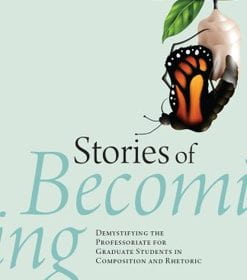From the Halmos College of Arts and Sciences and GHORC…

July 2023 Research Highlights reported by the Halmos College of Arts and Sciences and Guy Harvey Oceanographic Research Center (GHORC).

Claire Lutkewitte, Ph.D., Juliette C. Kitchens, Ph.D., and Molly J. Scanlon, Ph.D., in the Department of Communication, Media, and the Arts have earned the 2023 Conference on College Composition and Communication (CCCC) Research Impact Award Honorable Mention for their book Stories of Becoming: Demystifying the Professoriate for Graduate Students in Composition and Rhetoric. The CCCC Research Impact Award acknowledges an outstanding empirical research publication from the previous two years that advances the mission of the organization or the needs of the profession. Stories of Becoming integrates professional narratives and findings from a multiyear, nationwide study of new faculty in the field of rhetoric and composition to provide graduate students with specific strategies for preparing for a career in the professoriate.
Link to award description: https://cccc.ncte.org/cccc/awards/researchimpact; Link to book: https://upcolorado.com/utah-state-university-press/item/4094-stories-of-becoming

Tamara Frank Ph.D.
Tamara Frank Ph.D., Professor, Dept of Marine and Environmental Sciences
Presented talk at the 10th International Crustacean Congress, May 22-26, Wellington, New Zealand
Talk title: The Micronektonic Crustacean Assemblage in the Gulf of Mexico: Temporal Changes Since the Deepwater Horizon oil spill.
Interviewed for the Armatus Oceanic Deep-Sea Podcast: 036 – Crustacean Congress special — Armatus Oceanic
Former graduate student Dr. Ryan Bos (now starting a postdoctoral fellow at Harvard) just published the second paper from his Master’s thesis in Limnology and Oceanography: Microplastic Ingestion by Deep-Pelagic Crustaceans and Fishes

Louis R. Nemzer, Ph.D.
Louis R. Nemzer, Ph.D. Dept of Chemistry and Physics.
This paper is a great example of collaboration between student researchers and faculty among different departments, including: NSU DO School, NSU Halmos, NSU HPD, Indiana University, FAU, and Wake Forest School of Medicine.
- Autism spectrum disorder (ASD) has been shown to be associated with various other neurological disorders, particularly epilepsy. This leads to the notion that both conditions likely share similarities in their underlying disease pathophysiology, which may be linked to an imbalance between excitation and inhibition in the brain. In this review, we investigate the co-occurrence of ASD and epilepsy, with the intent of gaining insights into the similarities in causal factors.
- LINK: https://pubmed.ncbi.nlm.nih.gov/36819340/

Tracey Sutton, Ph.D.
Tracey Sutton, Ph.D. Dept of Marine & Environmental Science at the Halmos College of Arts and Sciences conducting research focused on Earth’s largest ecosystem, the pelagic ocean, from the surface to over 3 miles deep. Dr. Sutton is also founded and leads the DEEPEND Consortium (www.deependconsortium.org), a 125+-member, 22-institution organization focused on the dynamics of, and human impacts on, the deep sea. To date, 4 postdocs, 1 PhD, and 45 MS students at NSU have conducted research and earned degrees using DEEPEND samples and data.
Major research topics in Sutton’s Oceanic Ecology Lab include: the ecological structure of large deep-sea ecosystems (Gulf of Mexico, Sargasso Sea, US Atlantic Seaboard, North Atlantic, and Antarctic Seas); global deep-pelagic biogeography, management, and conservation; food web structure in deep-sea ecosystems; benthic-pelagic coupling in deep-sea ecosystems (reefs, canyons, slopes, seamounts).

This quarter’s highlights include four publications dealing with critical aspects of ocean ecology, all four of which included NSU graduate students or postdocs (3 of which were first-authored by students). These include:
- Vulnerability and resilience of living marine resources to the Deepwater Horizon oil spill: An overview. Frontiers in Marine Science 10:1202250. doi: 10.3389/fmars.2023.1202250.
- Ecomorphology of a predatory deep-sea fish family: does trophic specialization drive hyperspeciation? Frontiers in Marine Science. 10:1056094. doi: 10.3389/fmars.2023.1056094
- Body size, depth of occurrence, and local oceanography shape trophic structure in a diverse deep-pelagic micronekton assemblage. Progress in Oceanography 213:102998. doi.org/10.1016/j.pocean.2023.102998.
- Microplastic ingestion by deep-pelagic crustaceans and fishes. Limnology and Oceanography doi: 10:1002/lno.12370.
Sutton’s lab will soon begin a new chapter with a recently funded project to explore oceanic biodiversity in the Gulf of Alaska (NOAA Ocean Exploration). Time to buy some winter clothes….

Paul Baldauf, Ph.D.
Paul Baldauf, Ph.D. finished field research last week consisting of two data collection activities to support ongoing research on climate driven landscape development in the White River Badlands of South Dakota. Dept of Marine and Environmental Science
1) They collected a set of samples along the length of two parabolic dunes in the study area to be analyzed for age of deposition using optically stimulated luminescence. We hope that this study will refine the chronology we published previously in Aeolian Research in 2019. https://doi.org/10.1016/j.aeolia.2018.12.004
2) We collected drone imagery from two localities in the field area for use in the geomorphological analysis of strata deposited during the last glacial period in our field area. We want to know when these drought related sediments were deposited, the source of the sediments, and the rate of their accumulation.
The drone work follows on previous publication on use of high-resolution mapping in landscape analysis https://doi.org/10.1017/qua.2022.69
I’m attaching photos of the field areas and a link to a Vimeo showing a flyover of the area. https://vimeo.com/836601888